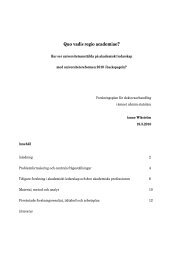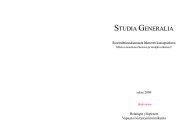the case of the 'urban villas'
the case of the 'urban villas'
the case of the 'urban villas'
You also want an ePaper? Increase the reach of your titles
YUMPU automatically turns print PDFs into web optimized ePapers that Google loves.
Simon A. Speksnijder, MPhil<br />
Ph.D. student, Ancient History<br />
University <strong>of</strong> Groningen<br />
Salutationes: <strong>the</strong> display <strong>of</strong> social relationships in <strong>the</strong> Roman domus<br />
On an average day in Late Republican or Early Imperial Rome, thousands flocked to <strong>the</strong><br />
domus <strong>of</strong> <strong>the</strong> elite to participate in <strong>the</strong> ritualized morning greetings known as salutationes. In<br />
this paper, I argue that <strong>the</strong> salutatio functioned as a vehicle to create, streng<strong>the</strong>n, and contest<br />
social relationships in full view <strong>of</strong> <strong>the</strong> whole city. As such, salutationes were nei<strong>the</strong>r ‘private’<br />
nor ‘public’.<br />
This paper consists <strong>of</strong> three parts. The first is a short introduction to <strong>the</strong> social<br />
functions <strong>of</strong> <strong>the</strong> salutatio. Visitors automatically engaged in an exchange‐relationship with<br />
<strong>the</strong> dominus simply by showing up. Their social position vis‐à‐vis each o<strong>the</strong>r, <strong>the</strong> host and his<br />
slaves was fur<strong>the</strong>r (re‐)defined and streng<strong>the</strong>ned during <strong>the</strong> morning greeting through various<br />
‘sub‐rituals’ involving <strong>the</strong> actual greeting and o<strong>the</strong>r exchanges.<br />
Secondly, I turn to <strong>the</strong> highly visible nature <strong>of</strong> salutationes. They were purposely<br />
staged to allow a large number <strong>of</strong> people (<strong>the</strong> visitors <strong>the</strong>mselves and o<strong>the</strong>r onlookers) to<br />
witness <strong>the</strong> social ritual. For example, visitors had to wait in <strong>the</strong> vestibulum, an area in front<br />
<strong>of</strong> <strong>the</strong> house bordering <strong>the</strong> street, where <strong>the</strong>y were subdivided into groups by slaves to enter<br />
<strong>the</strong> house in <strong>the</strong> right order.<br />
Thirdly, a study <strong>of</strong> <strong>the</strong> salutatio shows that ‘public’ and ‘private’ are unhelpful<br />
categories to characterize spaces in Roman domus and <strong>the</strong>ir various uses. The spaces used for<br />
salutationes (vestibula, atria and also cubicula) were employed for different purposes by<br />
different individuals during <strong>the</strong> day. It makes more sense to determine <strong>the</strong> level and control <strong>of</strong><br />
access (for <strong>the</strong> visitor and by <strong>the</strong> host respectively) and <strong>the</strong> level <strong>of</strong> visibility <strong>of</strong> whatever was<br />
played out (at any given moment in any given space) in order to distinguish between more<br />
‘open’ (accessible, visible) and ‘closed’ (inaccessible, less visible) spaces within domus.

















